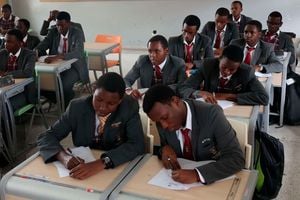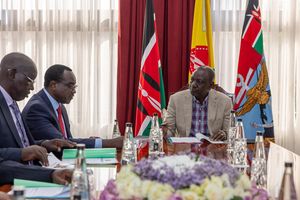Our Man: No deliberate benefits to residents of ‘presidential’ villages

Members of the public go about their business at Jua Kali trading centre in Uasin Gishu County. PHOTO | JARED NYATAYE | NATION MEDIA GROUP
What you need to know:
- We also visited Uasin Gishu, the home of Deputy President William Ruto, whose burning ambition for the presidency in 2022 has split the Jubilee Party down the middle.
- New roads criss-cross his former Eldoret North constituency, now divided into Soy and Turbo, but poverty endures.
- At Vumilia, which literally means persevere, families eke out a living on the rocky land that is not fit for human occupation.
The fast-growing Bondo town is sandwiched between two of Jaramogi Oginga Odinga’s properties. To the southwest is Kang’o ka Jaramogi (Jaramogi’s home), now a mausoleum, where the body of the doyen of opposition politics lies. Here Jaramogi (1911-1994) is the greatest political figure in the residents’ living memory.
To the east on the Bondo-Kisumu road is Opoda Farm, ODM leader Raila Odinga’s rural home. It is from this northern tip of the Winam Gulf (Kenya’s side of Lake Victoria), that the Odinga clan has cast a spell on Luo Nyanza politics since independence.
Even though the younger Odinga – the baton-bearer of the Jaramogi dynasty – has never represented a constituency in Nyanza, he has had a vice grip on the region’s politics since 1996, when he resigned from Ford-Kenya, the party of his late father, Masinde Muliro and Kijana Wamalwa, to chart his own course under NDP.
A visitor asking for directions to any of these Odinga homes receives an eager response from willing residents in Bondo.
Why are the Odingas so loved? “I can’t really explain. It is just like football. You can’t explain why you like one team or the other,” Mr Jacob Omondi, a boda-boda rider, explains the electrifying support that the ODM leader commands in the region.
Long marginalised
On further prodding, he informs me that Mr Odinga is the father of devolution, which has changed lives in the grassroots. He thinks that if Mr Odinga ascended to the presidency, he might bring “so many other things”.
Yet, as it is in Gatundu and Sacho (where, respectively, former presidents Jomo Kenyatta and Daniel arap Moi called home), so it is at Opoda Farm. Outside the impressive home, though a little unkempt at the time of our visit, a shanty town is coming up, reflecting the desperation of a people out to benefit from the crumbs dropping from the high table.
Elsewhere in the region, long marginalised by past governments, but also owing to its rather unkind climatic conditions, mud-walled and grass-thatched houses still dot the land, amid an increasing number of grand homes owned by the local elite.
Recently, there was an uproar when a government report revealed that Siaya, the home county of the Odingas, was one of the regions that were ill-prepared to handle a surge in the Covid-19 pandemic, with the devolved unit reportedly having only 14 Intensive Care Unit beds to serve its 993,183 residents (going by the 2019 census).
It later emerged that the county was no worse, nor better, than other regions, and that the outcry was enhanced by the expectation that the home county of a leader that has been agitating for better governance for more than 40 years ought to have fared better. He was a prime minister and a minister too, charged critics of the enigmatic Mr Odinga, popularly known as “Baba”.
Everywhere we went in the ‘presidential’ villages, the benefits that accrue to the common man such as roads and enhanced security only reached them as incidental, and not as deliberate, benefits.
Prof Odhiambo Ndege, who teaches history at Moi University and hails from Mr Odinga’s political backyard, says Siaya, and the rest of Luo Nyanza, has lagged behind the rest of the country because Jaramogi was not a revolutionary, but a populist leader.
“The Kenya People’s Union manifesto wasn’t any different from Sessional Paper Number 10 of 1965. Nyanza also suffered from two centres of power right from the beginning. Those of Tom Mboya and Oginga Odinga. One was young, ambitious and more articulate, the other old, traditional and more of a populist.”
But Prof Ndege’s assessment of Jaramogi’s contribution is disputed by other analysts from the region, who say the politician worked hard to develop the region.
They defend the politician as the embodiment of the typical Luo man who shared what he had.
“Jaramogi grew up in the traditional collectivist culture of the Luo society and was impressed by the Chinese and Russian development model that somewhat ensured the ordinary person was not left behind,” former Kenya Tourism Board managing director Dr Ongong’a Achien’g says.
He credits the founding vice-president for trying mightily to interest locals in business, chiefly by starting the Luo Thrift and Trading Union into which many bought shares.
“He did this in the 1940s, 1950s and early 1960s. He also took many young Kenyans to study abroad,” says the economist, himself a beneficiary of the Jaramogi airlifts.
He blames the underdevelopment in the region on Kenya’s first President Jomo Kenyatta’s isolationist policies after he parted ways with his VP.
Dr Achien’g, the son of Ramogi Achien’g Oneko, another freedom fighter, also offers insight into the different leadership styles between Jaramogi and Raila.
“Raila grew up in a different epoch, where private enterprise is king. He has a acquired a lot through various means,” Dr Achien’g says without elaborating.
He continues: “He is the custodian of Mzee’s (Jaramogi) aborted dream of the presidency. He is supposed to complete his father’s journey to the top, but not necessarily economically. His role is rather spiritual: to liberate the Luo from the stigmatisation of the past. In any event, his legacy in the fight for the second liberation and the Constitution is secure.”
We also visited Uasin Gishu, the home of Deputy President William Ruto, whose burning ambition for the presidency in 2022 has split the Jubilee Party down the middle.
New roads criss-cross his former Eldoret North constituency, now divided into Soy and Turbo, but poverty endures.
At Vumilia, which literally means persevere, families eke out a living on the rocky land that is not fit for human occupation.
At his Sugoi home, off Jua Kali township, on the Eldoret-Webuye road, the DP runs a model farm with pedigree cows, thousands of chickens, bananas, bees, avocado, mangoes and a small forest.
It is through this farming enterprise that Dr Ruto tries to maintain his roots to his humble childhood when he sold chickens by the roadside.
“The hustler nation idea sounds like an underdeveloped class concept that its proponents can’t go the whole hog because they are indeed not hustlers,” argues Prof Ndege, pointing to Dr Ruto’s fabulous wealth.
His generous donations to churches before the coronavirus disruption was a subject of awe and ire from his admirers and critics, respectively, who wondered where he gets all the money in a struggling economy.
Describing Dr Ruto’s legendary donations as tokenism, former Chepalungu MP John Koech says he hasn’t seen Dr Ruto’s attempt to fix the milk and maize sectors – the mainstay of the Rift Valley economy – and wonders how his ascension to power would benefit the region.
Historical baggage
“A majority of our people are living in extreme poverty and they grope in the dark, unguided, and looking for solutions in difficult circumstances. Yet I have never seen Dr Ruto pronounce himself on the matter,” says the former minister in the Moi and Kibaki administrations.
Dr Ruto’s defenders refer to the Jubilee administration’s ambitious road building and electrification of the country as a pointer of things to come were their man to ascend to the presidency.
Writing ahead of the 2013 elections, historian Charles Hornsby noted that the prospects that an Odinga presidency could create a radical renewal were unlikely.
“In part this is because he brings with him a weighty historical baggage of divisiveness. It is also because of the cynical populism he has sometimes shown and (not always of his own making) because of the response that his accession would bring amongst the Luo, anxious for their turn in the sun, and the Kikuyu who would withdraw their consent to be governed in a thousand ways,” wrote Hornsby, the author of Kenya: A History Since Independence.
So, even though the country has become far more mixed in reality, Kenyans continue to deploy ethnicity in multiple arenas.
The younger, better-educated socialise freely and intermarry easily, but they still understand that power in Kenyan politics is about creating and exploiting division, and the easiest division to exploit is ethnicity.
But as Hornsby warns, if the elites cannot find a means to rule without appearing to view all issues through the lenses of corruption, ethnicity and self-interest, danger is never too far on the horizon.
And that danger lurks — whether Ruto or Raila or any product of ethnic arithmetic ascends to the presidency.





